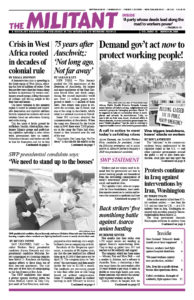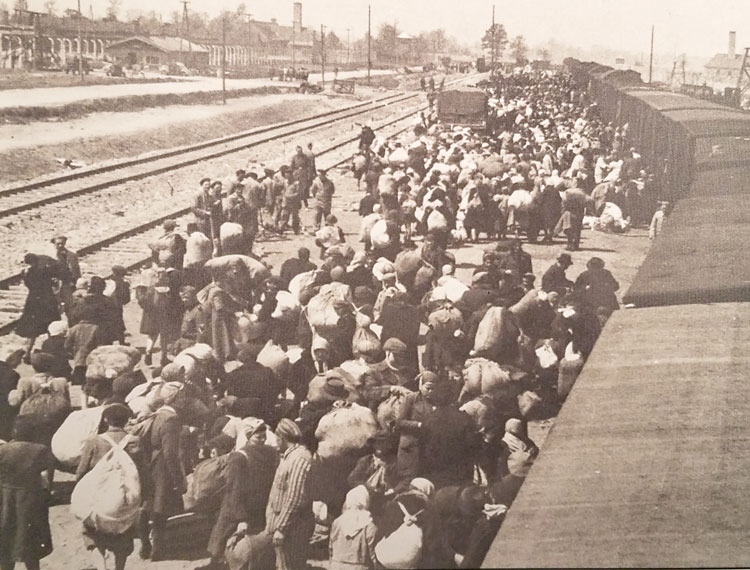NEW YORK — This January marked the 75th anniversary of the liberation of Auschwitz, the largest and most murderous of the Nazi German forced labor and death camps during the second imperialist world war. Over 1.1 million people were gassed to death — 1 million of them Jews. Two events took place to observe the occasion, one in Israel, and one at the camp in Auschwitz, which today is a national museum in Poland.
Some 200 survivors attended the commemoration at Auschwitz. When the camp was liberated by the Soviet army in 1945 there were 7,000 prisoners at the camp the Nazis had abandoned as they retreated near the end of the war.
“Auschwitz: Not Long Ago. Not Far Away” is the title for the exhibit at the Museum of Jewish Heritage in Manhattan about the Nazi concentration camp. Seventy-five years is not long ago, and Poland is not far away. The Holocaust has marked the evolution of world politics ever since.
The exhibit, which is spread out over three floors, is extensive and well-documented. It starts with the Polish town of Oswiecim (Auschwitz in German), the rise of the Nazi Party and its use of Jew-hatred to scapegoat Jews for the crisis afflicting the capitalist rulers in Germany, the onset of the imperialist world war, and the place of the Auschwitz camp in the Nazi’s plans for a “final solution” to eliminate the Jews.
Fascism, product of capitalist crisis
Coming out of their defeat in the First World War, the German rulers had been devastated. The victorious imperialist powers — Britain, United States, France and Italy — imposed the vindictive Versailles Treaty that saddled the German government with massive reparations.
One item in the exhibit shows this graphically. In 1910 a 1,000 mark note was worth $238, in February 1923 a 100,000 mark note was worth $2.40, in September 1923 a 10 billion mark note was worth $111. By October a 1 trillion mark note was worth $15. Runaway inflation devastated the middle and working classes.
The fascist German National Socialist Party, led by Adolf Hitler, emerged in this crisis, drawing on crushed petty bourgeois layers and demoralized workers. It attacked Jews and carried out physical assaults against unions and workers’ political organizations. As the crisis of German capitalism deepened, and working-class struggles grew, the capitalist rulers made the decision to back the Nazis to preserve their system.
The reformist Social Democratic Party and Stalinized Communist Party — both large and well-organized parties — refused to join in a united fight to mobilize the working class against the fascist threat. The CP, in the midst of its ultraleft “Third Period,” campaigned on the slogan, “After Hitler comes us.”
This betrayal of the German workers led to the victory of the Nazis and a stepped-up drive to crush the working class, using Jew-hatred as a key tool. None of this working-class history is reviewed in the exhibit. But describing the fascist party and its rise to power, the exhibit does explain, “Despite the party’s name, its focus had little to do with classic socialism and its desire for a classless society; rather the Nazi’s focus was the purity of the German or ‘Aryan’ race.”
“Fascism [in Germany] is a product of two conditions: a sharp social crisis on the one hand; the revolutionary weakness of the German proletariat on the other,” Leon Trotsky, a central leader of the Russian Revolution who was fighting to continue the revolutionary program of Lenin from exile, wrote in 1931. The exhibit describes Hitler’s persecution of the communists, and other working-class organizations and the unions.
The capitalist rulers in Washington and London refused to open their borders to Jews as the fascist assaults against them swept Germany. The Socialist Workers Party in the U.S. launched a call to action in 1938, “Let refugees into the United States! Open the doors to victims of Hitler’s Nazi terror!”
After Stalin signed a nonaggression pact with the Nazis in 1939, Hitler invaded Poland from the west while the Soviets did so from the east. The exhibit shows how Hitler began his first mass murder program in Berlin by killing what he called “useless eaters,” those who were disabled or mentally ill.
Auschwitz and the ‘final solution’
The exhibit shows how initially concentration camps were set up inside Germany, but once the war started the Nazis needed more camps to ramp up their displacement and killing of Jews and political opponents. Auschwitz was set up in 1940. Alongside the camp, factories were built to use labor from the camp. By mid-1942 the Nazis had decided Auschwitz would play a key role in what they called the “final solution.”
With scale models, clothing, actual structures, video clips, and life-sized photos, the exhibit documents the evolution of Auschwitz, how the Nazis systematically dehumanized all those deported there, and took mass killing to an industrial level. By 1943 four crematoria were being used at Auschwitz that could incinerate 4,416 corpses a day. From May to July 1944, over 430,000 Hungarian Jews were brought to Auschwitz. Most were sent to the gas chambers.
Much of the exhibit is built around showing the destruction that is unleashed when the capitalist class resorts to fascism, and the wholesale violence unleashed against the Jews, to save its economic and political system. The exhibit shows acts of solidarity and resistance by working people, however small — from people hiding Jews in their homes, to prisoners in the camp, not just Jews, maintaining their daily religious rituals and prayers, to prisoners taking pictures of the brutality and murder in the camps and smuggling the film out.
Workers’ road against anti-Semitism
One uprising occurred in October 1944 organized by the prisoners who were forced to move dead bodies from the gas chambers to be cremated. The revolt was defeated and participants killed, but it shows even in the most brutal and terrorizing conditions working people look for ways to assert their humanity and to resist.
The exhibit opens with a quote by Primo Levi, an Italian Jew who survived Auschwitz, stating, “It happened, therefore it can happen again.”
The deadly threat of Jew-hatred will remain as long as there is capitalist rule, especially in times of crisis. As Abram Leon, a leader of the communist movement in Belgium during the war, says in The Jewish Question, “The disappearance of Hitler can change nothing fundamental in the situation of the Jews.” Abram was killed at Auschwitz in 1944. That change can only happen when the working class is organized to lead all the oppressed and exploited to overthrow capitalist rule and put in place a workers and farmers government.
Humanity has not yet recovered from the horrors of the Holocaust. In 1939 the world Jewish population was 16,728,000. In 1945 it was 11,000,000. As of 2018 it is 14,606,000. It’s one thing to hear those numbers, but “Auschwitz: Not Long Ago, Not Far Away” is effective at putting on display what that means.
The exhibit at the Museum of Jewish Heritage runs through Aug. 30. Seeing it will deepen your appreciation of what was inflicted on Jews and the working class. To understand why this happened — and a road to prevent it ever happening again — I strongly recommend you get and read Abram Leon’s book.


